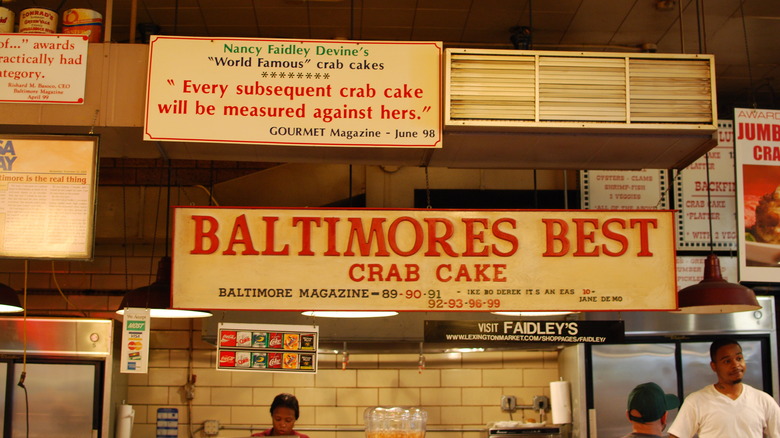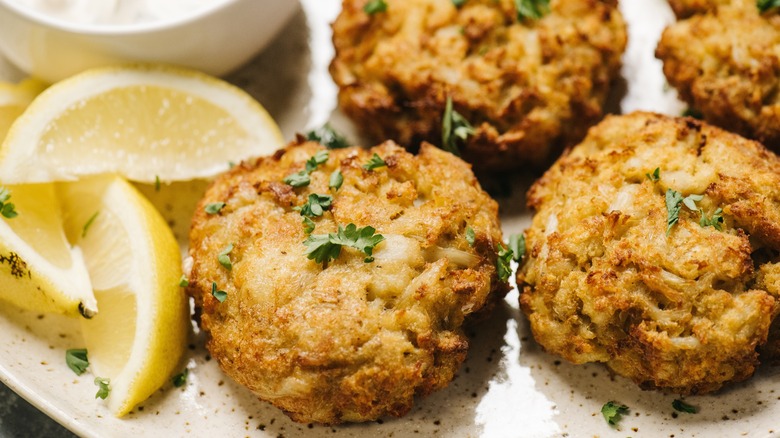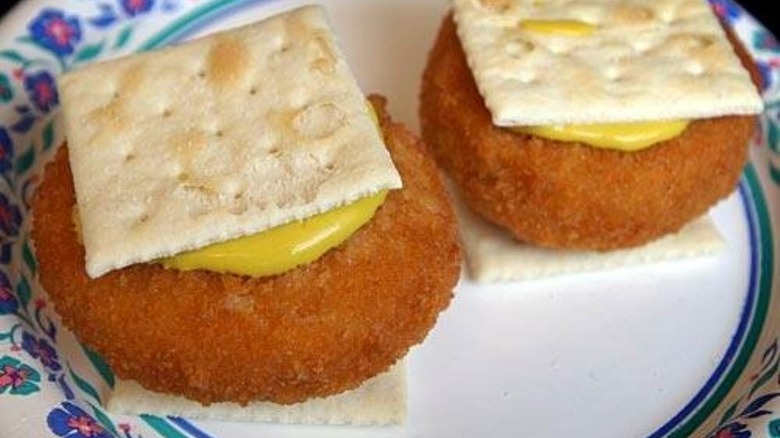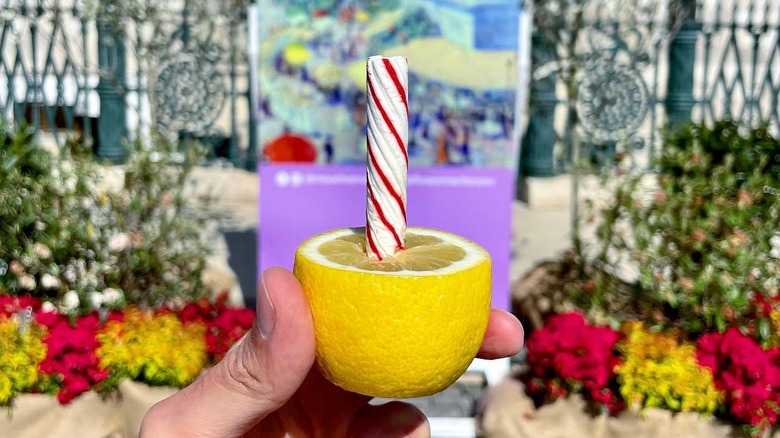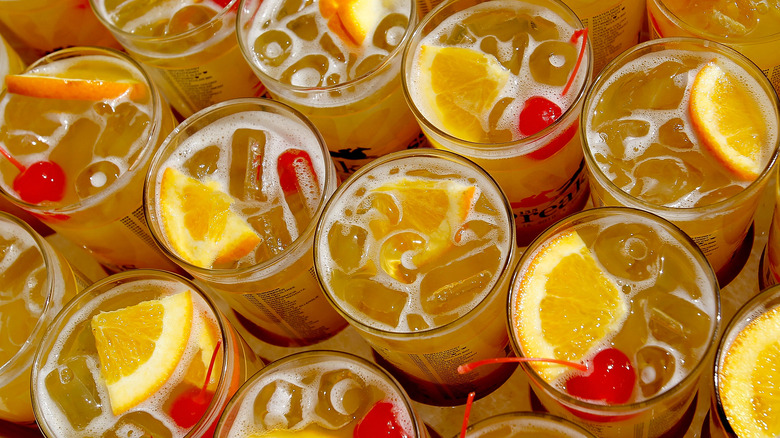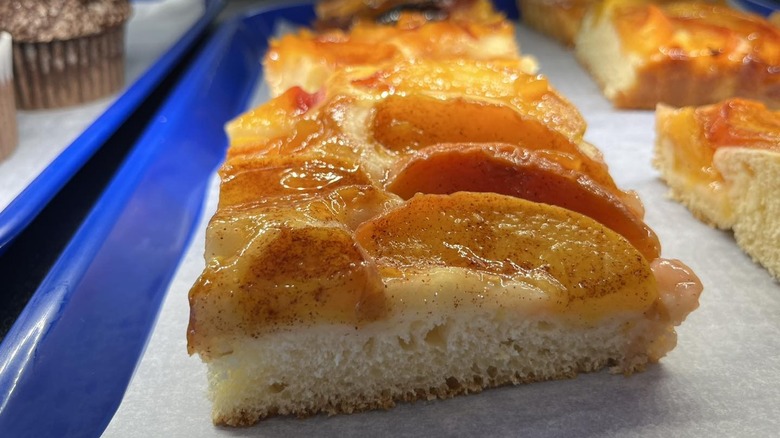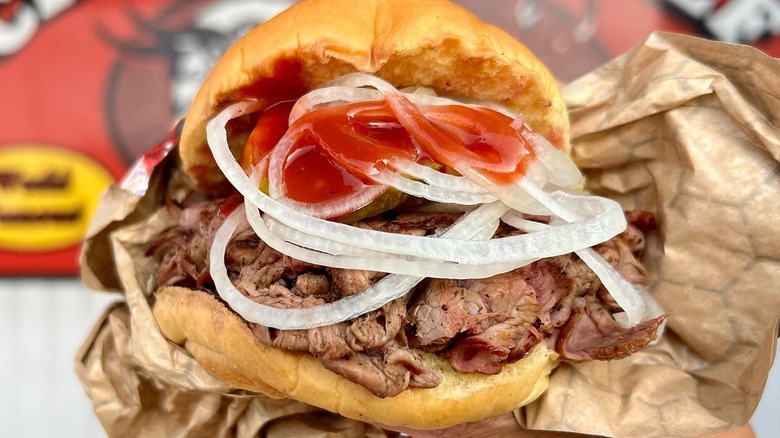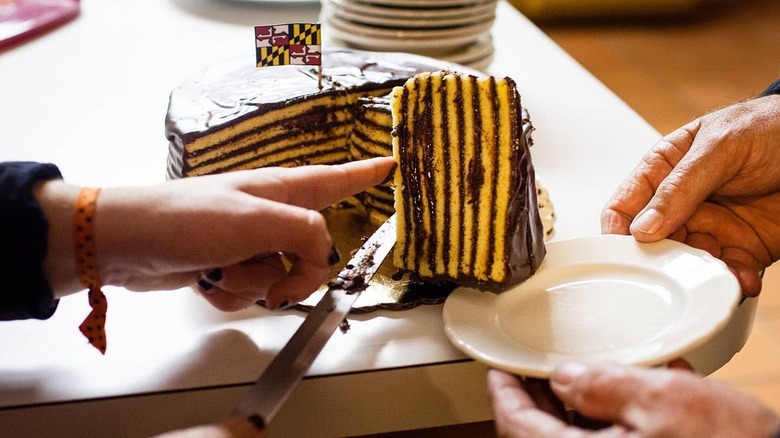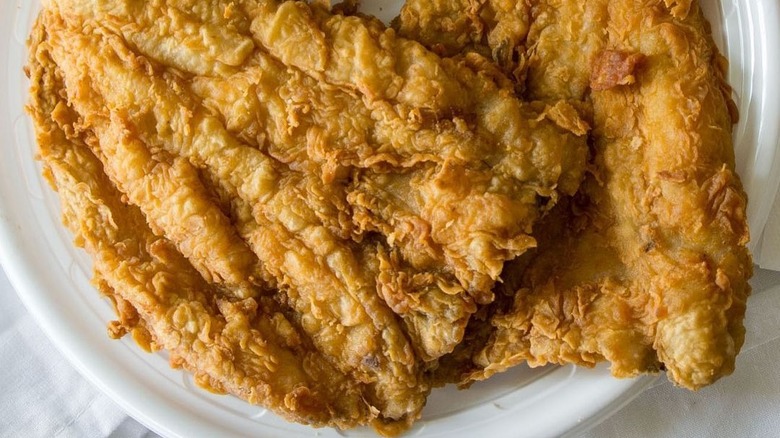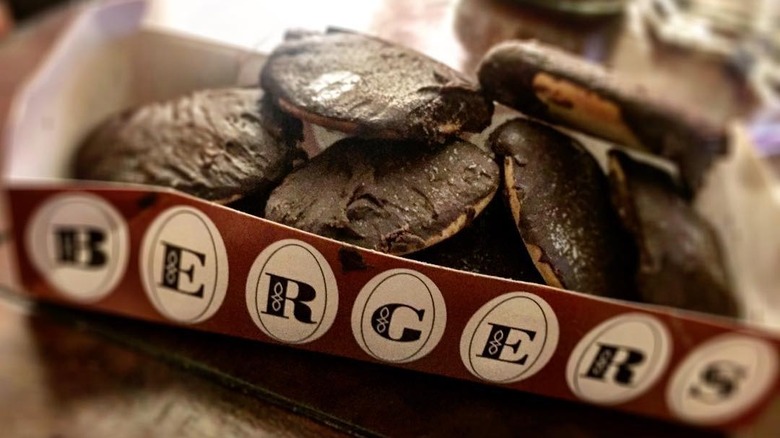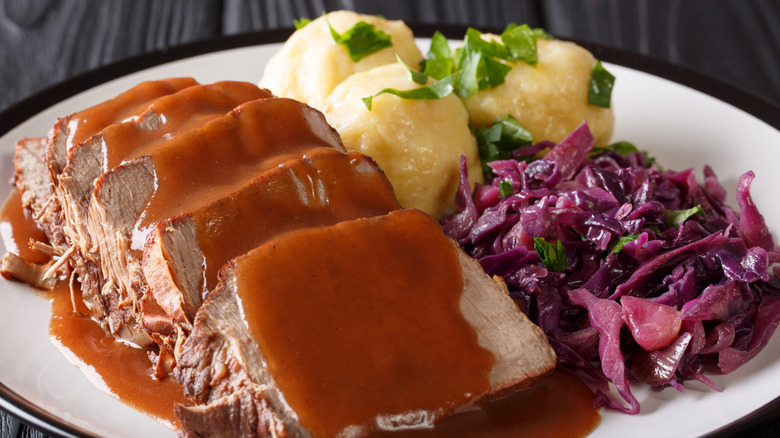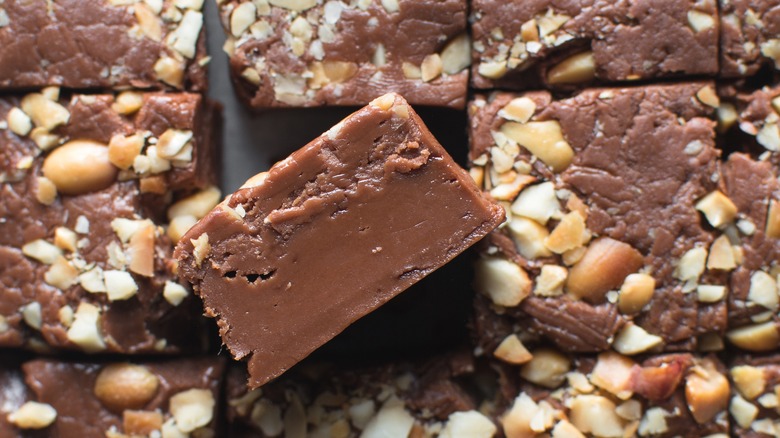12 Baltimore Delicacies You Need To Try
With numerous Michelin-star restaurants, hole-in-the-wall eateries, and year-round indoor markets, Baltimore is the foodie paradise no one talks about. The city boasts authentic cuisine from all corners of the globe, but it also has a distinct local gastronomy. From the Arabbers who still sell fresh fruit from horse-drawn carts to the pop-up summertime snowball stands that dot neighborhood sidewalks, Charm City's culinary delights speak just as much to Baltimore's personality as to its history.
With ample fresh seafood from the Chesapeake Bay, crabs, and oysters are common fare available from market stalls and upscale restaurants. But many Baltimore delicacies are the legacy of different communities that adapted their own culinary traditions to the bounties of the Mid-Atlantic. Taking influence largely from Indigenous, African, Jewish, and German cuisine, Baltimore fare is rich with a unique combination of flavors (and seasoned with much more than Old Bay). Many of the uniquely Baltimorean treats still enjoyed today are centuries old, and their originality inspires a fierce local pride. Here are 12 delicacies from Baltimore that all foodies need to try — some are seasonal, some perennial, but all are whimsically local.
Crab cakes
As the state food of Maryland, crab is a prevalent part of Baltimore cuisine, and crab cakes are a local staple. Baltimore's crab cakes comprise a patty packed with Maryland blue crab meat and bound together with breadcrumbs. Whether sautéed, boiled, baked, or fried, the city's most beloved seasoning for crab cakes is Old Bay spice — a magical mix that includes celery salt, pepper, and paprika — which also has Baltimore origins.
While crab cakes may have Charm City associations, they've actually been around much longer than the city itself. Native Americans in the Chesapeake Bay were the first people to cook crab cakes, using cornmeal in place of breadcrumbs, a variety of local herbs for seasoning, and frying everything in bear fat. Crab cakes may have been one of the first foods colonists adopted from indigenous Americans, and the age-old process of hand-extracting crab meat from the shell does not differ much from the methods employed today.
A longtime facet of Maryland cuisine, crab cakes became an important source of income for black Americans around the turn of the 20th century. "The honorable occupation of selling crabs... has been in vogue in Baltimore ever since the Civil War," The Baltimore Sun re-published from a 1905 article. "The Chesapeake Bay fairly teemed with crabs and large numbers of freed slaves took to the occupation of cooking and selling them." Black chefs' 19th century crab cake recipes are the variations still locally enjoyed and widely recognized today.
Snowballs
In a distinct middle ground between shaved ice and snow cones, Baltimore snowballs have been a summertime staple since the 1800s — or so the legend goes. While some may dispute Baltimore as the home of this unique icy treat, the city's ardent claim to 19th century snowball origins suggests that Baltimore's creation predates other American cities' similar confections.
Shaved ice actually derives from kakigori, an ice dessert that dates back to as early as 9th century Japan but wasn't brought to the US until the latter half of the 19th century, following Japan's colonization of Hawaii. A convenient means of keeping cool during Mid-Atlantic summers in a time before air conditioning, variations on ice treats found a natural — and possibly even essential — place in Baltimore daily life, becoming especially popular during the Great Depression. Also known as the "hard-times sundae", snowballs became an outlet for those experiencing hard times to make extra money. To this day, summertime pop-ups and homemade snowball stands are a common phenomenon in Baltimore neighborhoods.
While there are many possible flavors, egg custard is Baltimore's most traditional snowball flavor. The contemporary version entails a vanilla syrup harkening back to the mixture of eggs, vanilla, and sugar that Baltimoreans originally used to sweeten shaved ice. Snowballs are unique for the addition of marshmallows drizzled over the ice, though other snowball variations across the state — such as the Western Maryland "lollipop" — have been known to top their ice with soft-serve ice cream.
Coddies
A whimsically savory snack not to be mistaken as another name for cod cake, coddies are rather a kosher riff on a crab cake, but there are numerous myths about their provenance. Though Preservation Maryland suggests there may be an anthropological claim to coddies having African origins (since cod was historically inexpensive, enslaved peoples often cooked it), this deep-fried dish is commonly attributed to a family of Russian Jewish immigrants who made their mark on Baltimore in the early 1900s. Whether or not Leonard and Fannie Cohen were the true originators of the recipe, they're the reason coddies are locally renowned.
Coddies themselves are small deep-fried cod and potato cakes — the traditional recipe calls for salt cod and mashed potatoes. The end result is particularly recognizable for its unique presentation sandwiched between two saltine crackers with a dollop of mustard. Though coddies had humble beginnings when the Cohen family first sold them from a market stall, locals got a taste for these kosher crab cakes as soon as they tasted them. The Cohen's business expanded to deliver coddies across Baltimore to a wide pool of eateries — from bars to candy shops.
Coddies became harder to find after Cohen's Original Tasty Coddies closed their business in 1970, but by then, the snack had become a Baltimore fixture. While coddies are by no means as widely available as they once were, local chefs still turn to this nostalgic favorite, both adding new twists and keeping the traditional recipe alive.
Lemon sticks
Dating back more than a century, Baltimore's lemon stick is a seasonal sour-sweet treat and has always been served at the Flower Mart, an annual spring festival held in Baltimore's Mt. Vernon neighborhood since 1911. The lemon stick is a unique confection, not least for its ingenious simplicity and harmonious flavor contradictions. The configuration consists solely of a peppermint stick stuck into half a lemon — the sticky-sweet mint serves as a candy straw, clashing refreshingly with the sour lemon juice.
As for why or how the lemon stick came to be, no one knows for certain, but it is such a distinctly local treat that many Baltimoreans regard the lemon stick as a rite of passage to mark the change from spring into summer. Local eateries have certainly come to emphasize lemon stick season, infusing the unusual flavor pairing into seasonal delights to spread the minty tang further than the Flower Mart's well-attended lemon stick tent (which notoriously runs out before the festival's end). In this present-day lemon stick moment, one can find lemon and peppermint treats across the city throughout the summer, among them lemon stick-flavored cocktails, macaroons, ice cream and even snowballs.
"It's just kind of had a blossoming as a Baltimore brand," Lance Humphries, executive director of the Mount Vernon Place Conservancy, the nonprofit which hosts the Flower Mart, told The Baltimore Banner. The fierce local love for this lemon-peppermint combination has only solidified how truly Baltimorean the lemon stick has always been.
Black-Eyed Susan cocktail
The Kentucky Derby may have the mint julep, but the Preakness has the black-eyed Susan. This lesser-known fruit-forward beverage has been served as the official cocktail of The Preakness Stakes for 50 years. Running since 1873, the Preakness is one of the oldest events that bring visitors to Baltimore, drawing spectators to the city's Pimlico Race Course to experience this Triple Crown race. First introduced in 1973, 100 years after the first Preakness, the black-eyed Susan is almost exclusively proffered on the third Saturday in May each year when the race takes place.
While this cocktail may not be what brings people to the races specifically, it is a refreshing drink for a trackside day in the Mid-Atlantic's early summer. Named for Maryland's state flower, this drink was designed as a nod to the region. The recipes have varied widely over the years, as many black-eyed Susan iterations have come about largely to ensure that the elixir stays true to the pale yellow shade of the summer flower from which it gets its name. Oscillating from rum to bourbon to whisky and from orange to pineapple to peach, the black-eyed Susan has a more distinctly local association than flavor profile. Popularly garnished with a slice of orange and a maraschino cherry, this is not a drink that many people mix beyond racing season. As a lesser-known cocktail with specific Baltimore ties, it is a citrusy burst of local innovation that is not often mixed anywhere else.
Baltimore peach cake
A simple yeasted cake topped with sliced peaches, this dessert dates back to the 1880s, when Maryland peach harvests were particularly bountiful. Among the recipes devised to make use of fresh peaches before preserving the surplus for winter, the Baltimore peach cake is one still enjoyed today.
Though the dessert's genesis is a bit fuzzy, Baltimore peach cake has clear German origins. The rise of this dessert parallels an influx of German immigrants to this harbor city following the opening of an immigrant pier at Locust Point in 1868. This was part of an agreement that welcomed German families to the city to assemble workers for the B&O railroad, and the peach cake was one of many culinary traditions brought with them. German peach cake, also known as "Pfirsichkuche," is a virtually identical recipe — it's no surprise that this cake proliferated amongst the rising German community in Baltimore with access to such plentiful peaches.
The recipe's use of yeast as a leavening agent is also evidence of European influence, as yeasted cakes were a common facet of German baking even after the invention of baking powder. Beyond the use of yeast and peaches, this cake recipe is fairly flexible, though purists debate the shape of a true Baltimore peach cake and whether it should be topped with jam or powdered sugar. It remains a seasonal dessert available in sweet shops throughout the city, but despite its international heritage, it isn't well known beyond the Baltimore region.
Pit beef
Also known as pit barbecue, this unique Baltimorean beef sandwich has origins as hazy as its place under the barbecue descriptor. Some describe pit beef as closer to roast beef — and some claim only thick, hand-sliced beef makes pit beef authentic — but all agree that this humble beef sandwich got its start in Baltimore.
Pit beef first appeared in a working class part of town, served from roadside stands along the Pulaski highway, beginning as early as 1968. Originally, pit beef was defined by the specific method used to cook it. Traditionally it was made from hand-sliced top round roast cooked over hot coals, then served on a roll with horseradish or horseradish sauce, though barbecue sauce is another popular condiment (tomato-based, of course). Many locals, however, don't consider pit beef complete without tiger sauce, a mixture of horseradish and mayo that is also a Baltimore-specific flavor profile and another nod to the German culinary influences that have come to define much of the city's cuisine.
"Pit beef is not something you should plan for," Richard Gorelick, food critic for The Baltimore Sun, concluded in his survey of local pit beef vendors, "You should just stop when you see it, try it, and compare it to the other pit-beef sandwiches you've tried along the way." There is a sort of mythical appeal to the sandwich aside from its unique flavors, particularly because it's not uncommon to discover pit beef vendors in unexpected places around town.
Smith Island cake
Though it originates from nearby Smith Island, this dessert has become widely enjoyed throughout the Chesapeake Bay and, in 2008, was decreed Maryland's official dessert. The Smith Island cake isn't elaborate per se, but it is novel for the number of layers it boasts. Common versions call for 8-10 wafer-thin layers, each separated by its own layer of icing.
It could be that this many-layered dessert takes inspiration from European predecessors — the cake does somewhat resemble the Hungarian Dobos torte — but there is also a practical purpose for this unusual baking strategy. Smith Island didn't get electricity until the 1950s, prompting determined bakers to cook up sweets in metal boxes on top of wood stoves. This resourceful baking trick couldn't accommodate thick cakes, but thin ones were possible to cook all the way through. Adding enough thin layers rivaled the height of a conventionally baked layer cake, and the Smith Island take has the added benefit of additional layers of icing.
As local lore suggests, Smith Island cake is what the island's wives prepared to fortify their oystermen for long days during oyster season. Today the island exports more cakes than oysters, thanks to the Smith Island Baking Company operating just offshore. While pineapple, banana, and coconut are also popular flavors, the most iconic Smith Island cake pairs yellow cake with chocolate icing. The even dispersal of cake and icing in any given forkful speaks to a profound decadence from this dessert's innovative simplicity.
Lake trout
Unlike the crab cake, which has begun to appear on increasingly more upscale restaurant menus, lake trout is another Baltimore seafood specialty that remains as humble as it ever was. A fixture in working class neighborhoods since the 1920s, locals still line up for lake trout at market stalls and fast food restaurants across the city. A lake trout meal comes with a bundle of fried fish served with hot sauce and slices of white bread, the whole assembly commonly stuffed into a paper bag to go.
Lake trout isn't actually trout, nor does it come from a lake — it isn't even a fish that's local to Maryland waters. Rather, the fish used for lake trout is whiting, a bottom feeder commonly found in the eastern North Atlantic. Battered whiting under different names is a common form of fried fish available throughout the country, but Baltimore is the only place that calls it lake trout. Either breaded or battered, the fish is fried whole, including the head and tail, and the bones are intentionally left intact — the trick is to eat around them. "You need the bones to hold the fish together. And the batter, too," Ivy Anderson, retired steelworker and lake trout aficionado, told the New York Times. "Fry it hard and the fish holds together. Fry it soft, and you have a mess." Locals like to pair lake trout with half and half, their name for an Arnold Palmer, which washes everything down nicely.
Berger Cookies
Conceptualized in the bakery of German immigrant Henry Berger, these eponymous iced cookies share a similar sweet philosophy to the black-and-white cookies originating in New York but predate the black and whites by at least 65 years. First introduced in 1835, Berger cookies have been beloved from the start, quelling any sweet tooth with the rich and sublime combination of shortbread hand-dipped in a layer of chocolate fudge icing as thick as the cookie itself.
Berger and his sons originally sold their cookies in public markets across the city, and their legacy lives on through the cookie stands still operating in a number of Baltimore's lasting indoor markets. Today, Berger Cookies can also be found in grocery stores throughout Baltimore and have spread to a few sellers in the surrounding area, but somehow they still remain a mostly local phenomenon.
Some claim the Berger cookie is exclusively about the chocolate topping, and thus the mildly-flavored shortbread component isn't worth eating. But according to Charles DeBaufre Jr., Berger cookies' current owner, the strategy has always been to let the chocolate take center stage. "The bottom portion of the cookie is a vanilla wafer with virtually no taste at all. That's intentional," he explained to the Maryland Daily Record. "That way, the wafer doesn't detract from or lose its flavor to the flavor of the chocolate fudge on top." There's always been something special about the recipe for the cookie's chocolate fudge topping, which hasn't changed in nearly 200 years.
Sour beef and dumplings
Another seasonal dish taking German inspiration, sour beef and dumplings, appears in many forms during the fall. This is a Baltimore take on the German dish sauerbraten, a marinated pot roast that gets stewed with a large array of spices (among them vinegar and cloves) and served with potato dumplings. Sauerbraten is among Germany's national dishes and takes on many forms. Sometimes Baltimore's version of sauerbraten appears as more of a stew, other times simply beef and dumplings slathered in gravy. No matter what form the dish takes, the flavor derives an acquired taste from the unexpected ingredient used to thicken the sauce — gingersnaps. Crushed gingersnaps are a signature in traditional sauerbraten recipes and perhaps one reason why the dish is associated with the holiday season in Baltimore.
Usually served with red cabbage and beer on the side, a plate of sour beef and dumplings is a robust meal that evokes the flavors of another place and time.It's not a dish to be eaten often and is probably best enjoyed at one of the annual holiday sour beef and dumpling dinners hosted at a number of local churches, where servers sport traditional German garb for the occasion. But a few restaurants in the area do prepare sour beef and dumplings more regularly, and they all serve the sweet-savory-sour dish with the signature gingersnap gravy. For dessert to follow this well-spiced meal, the German-influenced Baltimore peach cake is usually within reach.
Fudge
Fudge could be a variation on recipes for older European confections — Scottish tablet, for example, is a similar sweet that dates back to the 1700s, and caramels became popular in Europe around the same time. Food historian Joyce White told CBS that fudge likely came from a "fudged" recipe for chocolate caramels and specifically states Baltimore as the place where this fortuitous mistake took place.
Though it isn't clear who in Baltimore is responsible for the creation of fudge, further evidence continues to point to Charm City as the place of origin. Popular lore suggests fudge first appeared in the dormitories of girls' colleges at the end of the 19th century, and Emelyn Hartridge, a Vassar College alumna, is often credited as the dessert's inventor. Hartridge started this girls' college tradition when she first sold fudge at a school auction in 1888, and the recipe she includes in a letter is the first known recorded recipe for the sweet. But Hartridge herself voiced no claim to the dessert — her letters also explain that she got her fudge recipe from a schoolmate, who got it from a cousin in Baltimore. Hartridge herself was aware of fudge being sold in Baltimore as early as 1886.
In the end, it may be perfectly sensical that fudge first arose in Baltimore. The chocolate "icing" that has topped Berger cookies since 1835 is essentially fudge itself, and the continued popularity of this chocolatey decadence proves Baltimoreans have a taste for it.
